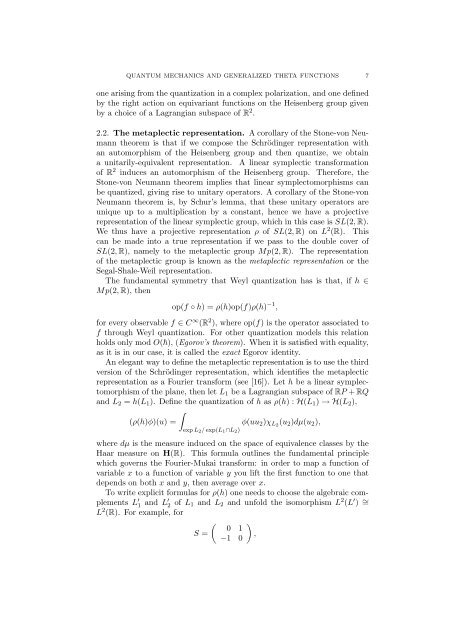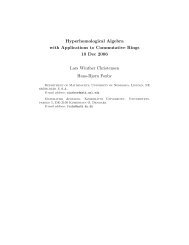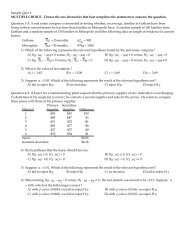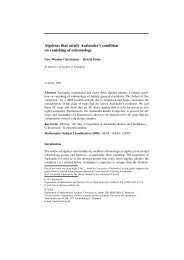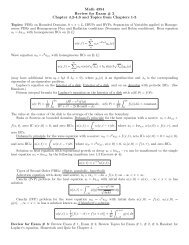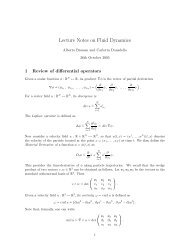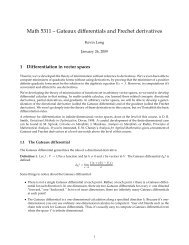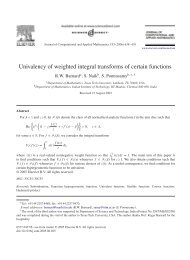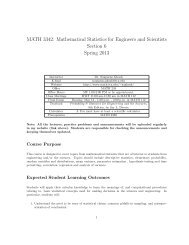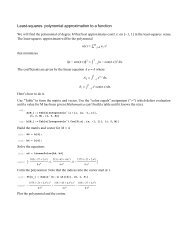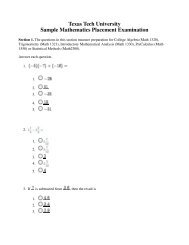QUANTUM MECHANICS AND NON-ABELIAN THETA FUNCTIONS ...
QUANTUM MECHANICS AND NON-ABELIAN THETA FUNCTIONS ...
QUANTUM MECHANICS AND NON-ABELIAN THETA FUNCTIONS ...
You also want an ePaper? Increase the reach of your titles
YUMPU automatically turns print PDFs into web optimized ePapers that Google loves.
<strong>QUANTUM</strong> <strong>MECHANICS</strong> <strong>AND</strong> GENERALIZED <strong>THETA</strong> <strong>FUNCTIONS</strong> 7one arising from the quantization in a complex polarization, and one definedby the right action on equivariant functions on the Heisenberg group givenby a choice of a Lagrangian subspace of R 2 .2.2. The metaplectic representation. A corollary of the Stone-von Neumanntheorem is that if we compose the Schrödinger representation withan automorphism of the Heisenberg group and then quantize, we obtaina unitarily-equivalent representation. A linear symplectic transformationof R 2 induces an automorphism of the Heisenberg group. Therefore, theStone-von Neumann theorem implies that linear symplectomorphisms canbe quantized, giving rise to unitary operators. A corollary of the Stone-vonNeumann theorem is, by Schur’s lemma, that these unitary operators areunique up to a multiplication by a constant, hence we have a projectiverepresentation of the linear symplectic group, which in this case is SL(2, R).We thus have a projective representation ρ of SL(2, R) on L 2 (R). Thiscan be made into a true representation if we pass to the double cover ofSL(2, R), namely to the metaplectic group Mp(2, R). The representationof the metaplectic group is known as the metaplectic representation or theSegal-Shale-Weil representation.The fundamental symmetry that Weyl quantization has is that, if h ∈Mp(2, R), thenop(f ◦ h) = ρ(h)op(f)ρ(h) −1 ,for every observable f ∈ C ∞ (R 2 ), where op(f) is the operator associated tof through Weyl quantization. For other quantization models this relationholds only mod O(), (Egorov’s theorem). When it is satisfied with equality,as it is in our case, it is called the exact Egorov identity.An elegant way to define the metaplectic representation is to use the thirdversion of the Schrödinger representation, which identifies the metaplecticrepresentation as a Fourier transform (see [16]). Let h be a linear symplectomorphismof the plane, then let L 1 be a Lagrangian subspace of RP +RQand L 2 = h(L 1 ). Define the quantization of h as ρ(h) : H(L 1 ) → H(L 2 ),∫(ρ(h)φ)(u) =φ(uu 2 )χ L2 (u 2 )dµ(u 2 ),exp L 2 /exp(L 1 ∩L 2 )where dµ is the measure induced on the space of equivalence classes by theHaar measure on H(R). This formula outlines the fundamental principlewhich governs the Fourier-Mukai transform: in order to map a function ofvariable x to a function of variable y you lift the first function to one thatdepends on both x and y, then average over x.To write explicit formulas for ρ(h) one needs to choose the algebraic complementsL ′ 1 and L′ 2 of L 1 and L 2 and unfold the isomorphism L 2 (L ′ ) ∼ =L 2 (R). For example, forS =(0 1−1 0),


